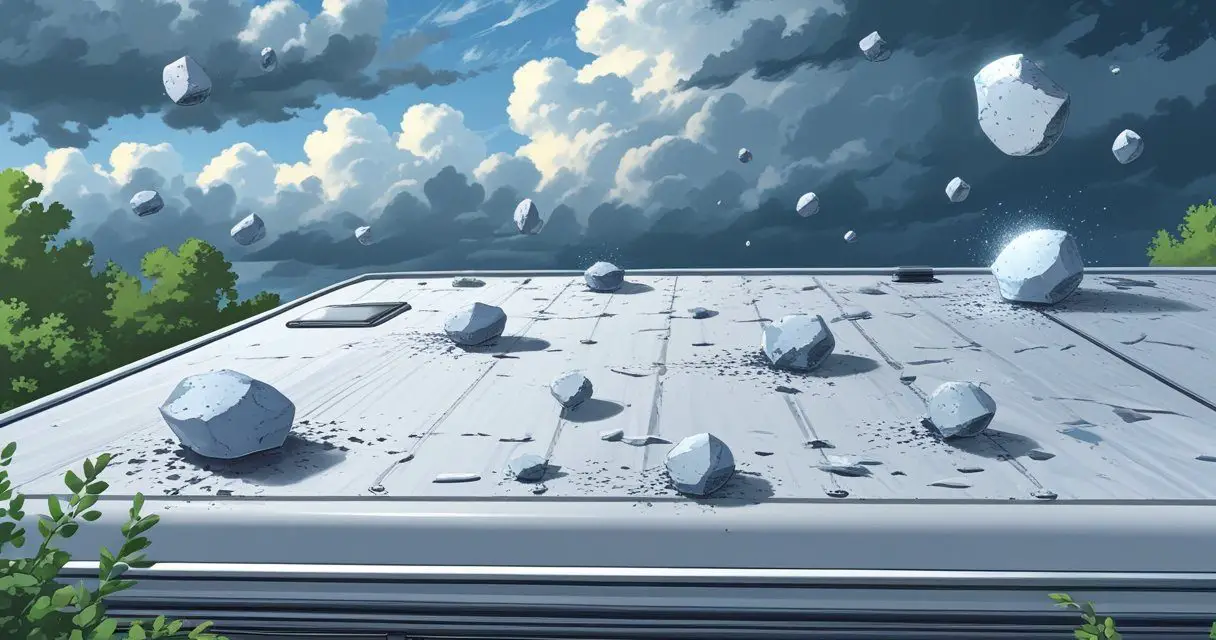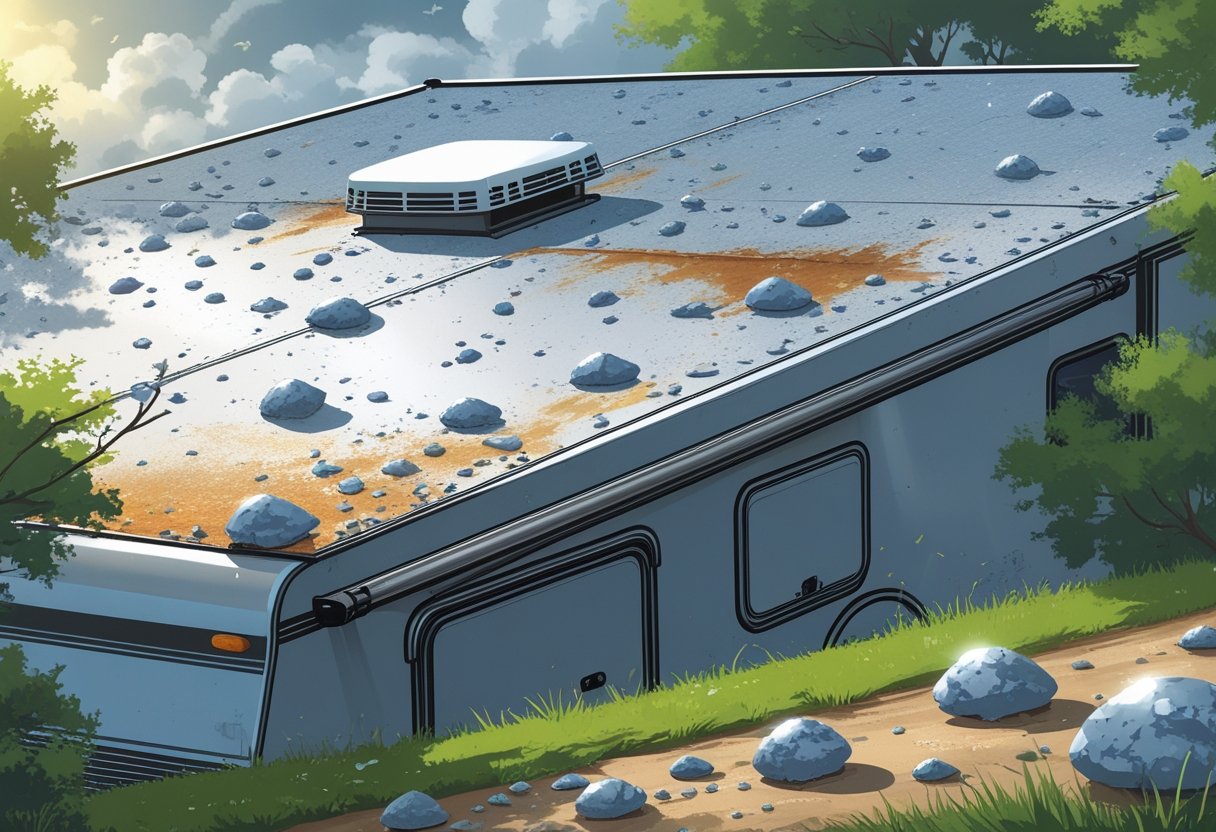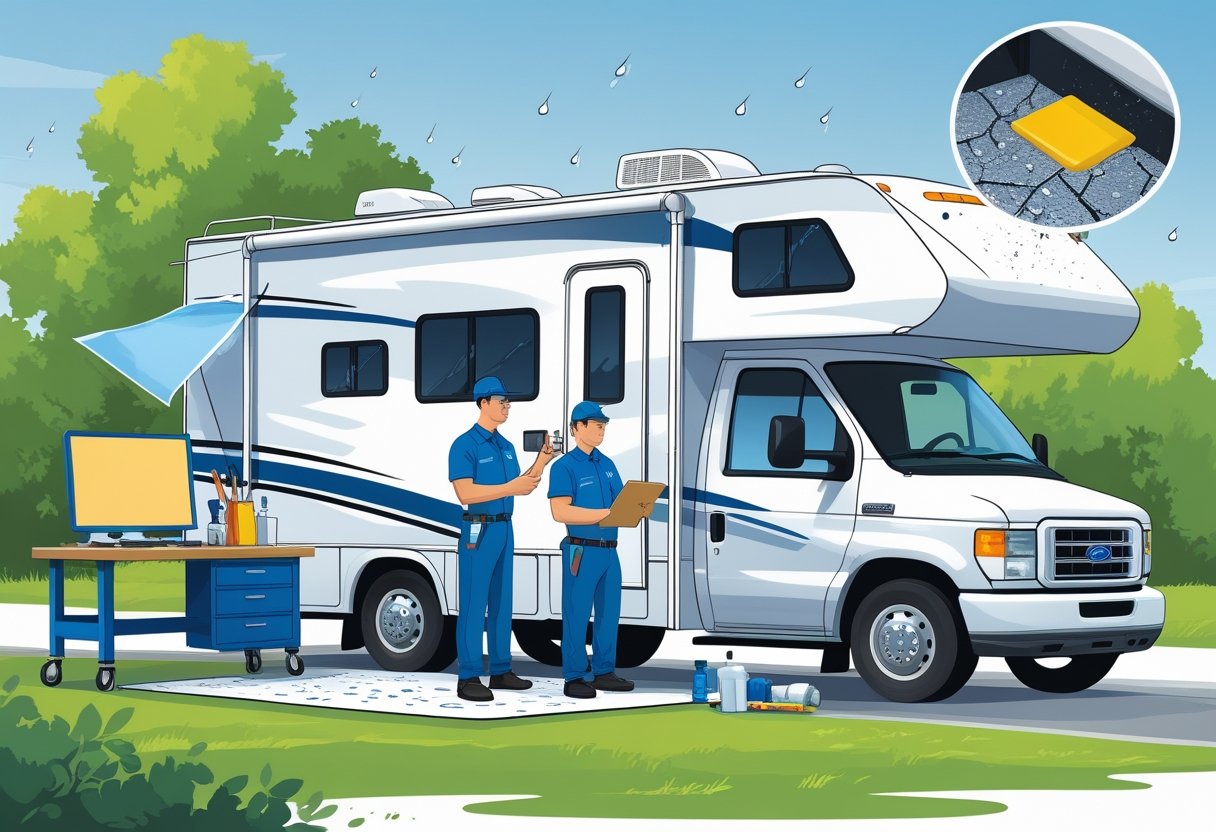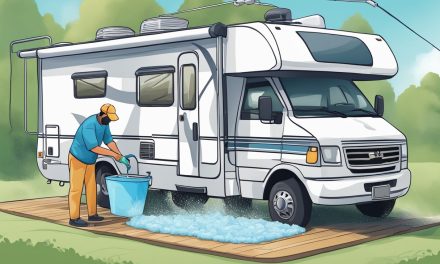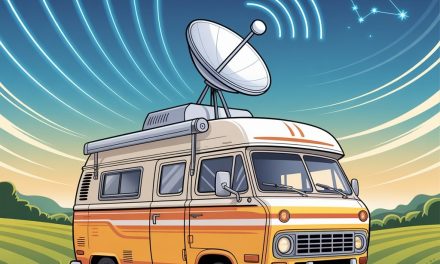Would you like to save this article?
Yes, hail can absolutely damage your RV roof, and the damage can be both costly and dangerous if left untreated. Hailstones can create dents, cracks, and even holes in your RV’s roof depending on their size and the force of impact. The damage often goes beyond what you can see on the surface.
RV roofs are particularly vulnerable to hail because they’re made from materials like rubber, fiberglass, and aluminum that can be easily damaged by ice balls falling from the sky. Unlike car dents that can often be popped out, RV roof damage usually requires more complex repairs since these roofs have multiple layers including insulation and wood underneath.
Understanding how to spot hail damage early and knowing your repair options can save you thousands of dollars in water damage repairs. This guide will walk you through everything you need to know about protecting your RV from hail and dealing with damage when it happens.
Key Takeaways
- Hail creates dents, cracks, and holes in RV roofs that can lead to expensive water damage if not repaired quickly
- Different roof materials like rubber and fiberglass have varying levels of vulnerability to hail damage
- Prompt repair and proper insurance coverage are essential for protecting your investment from long-term consequences
Understanding Hail Damage to RV Roofs
Hail can cause serious damage to RV roofs depending on the size of the hailstones and the materials used in your roof. Different roofing materials react differently to hail impact, and damage can range from small dents to complete punctures that cause immediate leaks.
How Hail Impacts Different RV Roof Materials
Rubber roofs are the most common type on RVs today. EPDM and TPO rubber membranes can handle small hail well. However, larger hailstones can puncture these materials easily.
The rubber stretches when hit but may not bounce back completely. This creates weak spots that can tear later.
Fiberglass roofs are harder than rubber but more brittle. Small hail often bounces off without damage. Large hailstones can crack the surface or create spider web patterns.
These cracks let water seep through over time. Temperature changes make the cracks bigger.
Aluminum roofs dent easily from hail of any size. The dents rarely cause immediate leaks. But they can collect water and debris.
Deep dents may stretch the metal thin. This makes it more likely to develop holes later.
Metal roofs like steel handle hail better than aluminum. They still dent but usually don’t puncture. Paint damage is common and can lead to rust.
Common Signs of Hail Damage on RVs
Visible dents are the most obvious sign of hail damage to rv roofs. Look for round or oval-shaped depressions across the roof surface.
Check all roof accessories too. Vents, air conditioners, and skylights often show damage first.
Cracks or tears in rubber roofing appear as dark lines or splits. These may be hard to see at first. They often show up better when the roof is wet.
Granule loss on any textured roof surfaces indicates hail impact. You might find small pieces of roofing material on the ground around your RV.
Water stains inside your RV point to roof damage. Check ceilings and walls for brown spots or soft areas. These signs mean water is already getting through.
Damaged seals around roof fixtures are common after hailstorms. The sealant may be cracked, missing, or pulled away from vents and other openings.
Types of Roof Damage Caused by Hail
Surface damage includes dents, scratches, and small cracks that don’t go all the way through. This type of damage may not leak right away. But it weakens the roof and can cause problems later.
Puncture damage happens when large hail breaks completely through the roof. This causes immediate leaks and needs fast repair. Water damage to the inside of your RV starts quickly.
Membrane damage affects the waterproof layer of your roof. Even small holes in this layer let water through. The damage may be tiny and hard to find.
Structural damage occurs when very large hail hits hard enough to damage the roof deck underneath. This type of damage is serious and expensive to fix. It can affect the strength of your entire roof system.
Seal damage around roof fixtures is very common after hailstorms. Broken seals let water in even if the main roof surface is fine. This damage is often overlooked but causes major problems.
RV Roof Materials and Susceptibility to Hail
Different RV roof materials respond uniquely to hail impact, with some showing immediate visible damage while others develop hidden problems over time. Understanding how rubber, fiberglass, and TPO roofs handle hailstorms helps you assess damage and plan repairs.
Rubber Roof Vulnerability and Granule Loss
Rubber roofs made from EPDM material are among the most vulnerable to hail damage. The soft rubber surface dents easily when struck by even small hailstones.
Granule Loss Patterns:
- Small hail (pea-sized) removes protective granules
- Medium hail creates visible dents and tears
- Large hail can puncture the membrane completely
The granules on rubber roofs protect against UV rays and weathering. When hail removes these granules, your roof becomes more vulnerable to sun damage and cracking.
Dents in rubber roofs often appear minor at first. However, these dents collect water and debris over time. The constant pooling weakens the rubber and leads to cracks.
Common Damage Signs:
- Exposed black rubber where granules are missing
- Small tears around the impact points
- Indentations that hold standing water
Fiberglass Roof Cracking and Fractures
Fiberglass roofs handle small hail better than rubber but suffer significant damage from larger stones. The rigid material tends to crack rather than dent when struck.
Hailstones create stress fractures that may not be visible immediately. These hairline cracks expand with temperature changes and vehicle movement. Water seeps through these cracks and damages the wood underneath.
Typical Damage Patterns:
- Spider web cracks around impact points
- Gel coat chipping and flaking
- Deep gouges from large hailstones
Fiberglass repairs are more complex than rubber roof fixes. You cannot simply patch the damaged area. The entire section often needs refinishing to restore structural integrity.
Older fiberglass roofs are more susceptible to hail damage. The material becomes brittle over time and cracks more easily under impact.
TPO Roof Performance in Hailstorms
TPO roofs offer better hail resistance than traditional rubber roofs. The thermoplastic material bounces back from small hail impacts without permanent damage.
Medium-sized hail may create temporary dents that disappear as the material returns to its original shape. However, large hailstones can still puncture or tear TPO membranes.
TPO Advantages:
- Better impact resistance than EPDM rubber
- Self-healing properties for minor damage
- Stronger seam welding reduces leak points
TPO roofs maintain their protective qualities better after hail exposure. The material does not rely on granules for protection like rubber roofs do.
Despite better performance, TPO roofs are not hail-proof. Severe storms with golf ball-sized hail or larger can cause significant damage requiring professional repair.
Detecting and Assessing Roof Damage After a Hailstorm
Finding hail damage on your RV roof requires checking both visible surface problems and hidden issues that can cause water leaks later. Small dents and cracks may seem minor but can lead to serious water damage if you don’t address them quickly.
Visual Inspection Methods
Start by looking at your RV roof from the ground using binoculars. Check for obvious dents, cracks, or holes in the roofing material.
Look for these common signs of hail damage:
- Small dents or divots in the roof surface
- Cracks or fractures in fiberglass or rubber roofing
- Missing or damaged roof accessories like vents, skylights, or air conditioning units
- Granule loss on rubber roofs where protective coating has been knocked off
Climb onto your RV roof only if you can do so safely. Walk carefully and avoid stepping on damaged areas.
Run your hand gently over the roof surface. You may feel dents that are hard to see with your eyes alone.
Take photos of any damage you find. These will help with insurance claims and repair estimates.
Pay special attention to areas around roof penetrations like vents and skylights. These spots are more likely to develop leaks after hail damage.
Hidden Damage and Secondary Issues
Not all hail damage is easy to spot right away. Some problems develop over time and can cause bigger issues later.
Check the roof membrane integrity by looking for small punctures or weak spots. Press gently on suspicious areas to see if they feel soft or spongy.
Inspect seams and joints where different roof materials meet. Hail can loosen these connections even when the main roof looks fine.
Look at roof supports from inside your RV. Check the ceiling for sagging or new creases that might show structural damage.
Insulation problems can happen when hail creates small holes. Feel for cold or warm spots on interior walls that weren’t there before.
Some damage gets worse with temperature changes. Small cracks can grow larger when the roof expands and contracts in different weather.
UV exposure increases when hail removes protective coatings. This leads to faster aging and cracking of roofing materials.
Water Leaks and Water Damage Warning Signs
Water damage often shows up days or weeks after a hailstorm. Check these areas regularly after any hail event.
Look for water stains on your RV’s ceiling and walls. Brown or yellow spots often appear near roof edges or around fixtures.
Check for soft spots in ceiling panels or walls. Press gently to find areas that feel spongy or give way under light pressure.
Musty odors can signal hidden water damage inside walls or insulation. This smell often appears before you can see visible water stains.
Inspect electrical fixtures and outlets near the ceiling. Water damage can create serious safety hazards with your RV’s electrical system.
Test windows and skylights by looking for moisture between glass panes or new condensation patterns.
Monitor these areas during and after rain storms. New leaks may only show up when water hits the roof at certain angles.
Mold growth can start within 24-48 hours of water exposure. Look for dark spots or fuzzy growth in corners and along seams.
Long-Term Consequences of Hail Damage on RV Roofs
Hail damage to RV roofs creates serious problems that get worse over time. Small cracks and dents allow water to enter your RV, which leads to expensive repairs and health risks.
Structural Weakening and Insulation Issues
Water gets into your RV through tiny holes and cracks from hail damage. This water soaks into the roof structure and weakens the materials that keep your RV strong.
The wooden parts under your roof can rot when they stay wet. Metal parts can rust and become weak. Your roof may start to sag or feel soft when you walk on it.
Water damage also ruins your insulation. Wet insulation loses its ability to keep heat in or out. This makes your RV harder to heat in winter and cool in summer.
Your energy bills will go up because your air conditioner and heater have to work harder. The insulation may need to be replaced completely, which costs hundreds or thousands of dollars.
Roof damage from hail gets worse each time it rains. What starts as a small problem becomes a major repair job.
Decreased Resale Value
Hail damage to RV roofs hurts the value of your RV when you try to sell it. Buyers can see the damage and know it means trouble.
Most buyers will offer much less money for an RV with hail damage. They worry about water damage and future repair costs. Some buyers will not buy a damaged RV at all.
Your RV could lose 10-30% of its value depending on how bad the damage is. A $50,000 RV might only sell for $35,000 or less with hail damage.
Insurance records show the damage history. This makes it hard to hide the problem from buyers. Even if you fix the damage, buyers may still worry about hidden problems.
Getting your roof fixed properly can help protect your RV’s value. But waiting too long makes the damage worse and harder to fix.
Mold Growth and Health Concerns
Water from hail damage creates the perfect place for mold to grow inside your RV. Mold needs moisture and dark spaces, which damaged roofs provide.
Mold can grow behind walls where you cannot see it. It spreads through your RV’s air system and can make you sick. Common health problems include:
- Breathing trouble and coughing
- Skin rashes and eye irritation
- Headaches and feeling tired
- Worse symptoms for people with asthma
Black mold is especially dangerous and can cause serious health problems. Children and older adults are at higher risk from mold exposure.
Cleaning up mold is expensive and difficult. You may need to replace walls, floors, and furniture. Some RVs become unsafe to use and cannot be fixed.
The smell from mold and water damage makes your RV unpleasant to use. Professional mold removal can cost thousands of dollars.
Repair Options and Preventative Measures
RV roof repair depends on damage severity and roof material, with professional services offering specialized techniques like FlexArmor coatings and paintless dent removal. Prevention strategies include protective coatings, reinforced materials, and proper maintenance of vulnerable areas.
Professional Repair Solutions
Professional repair services offer specialized techniques for different types of hail damage on your RV roof. For minor dents on metal surfaces, some technicians use paintless dent removal (PDR) methods that preserve your RV’s original finish.
Rubber roof repairs typically involve:
- Complete damage assessment and inspection
- Removal of damaged membrane sections
- Application of new rubber roofing material
- Sealing around vents and penetrations
Fiberglass roof restoration includes patch repairs or full panel replacement depending on impact severity. Professional services like FlexArmor create seamless, puncture-resistant surfaces that bond directly to your existing roof.
Many repair shops offer specialized coatings like Rhino Spray-On Roof Lining. These protective layers prevent future roof replacements and provide enhanced hail resistance for your RV.
Do-It-Yourself Repairs and Limitations
Small hail damage repairs on rubber roofs can be manageable DIY projects. You can patch minor punctures using rubber roof repair kits and sealants available at RV supply stores.
DIY repair limitations include:
- Complex layered roof construction (rubber, oriented strand board, framing, insulation)
- Risk of improper sealing leading to water damage
- Difficulty accessing structural damage beneath surface materials
- Lack of specialized tools and materials
Fiberglass roof repairs require professional expertise due to material complexity. Attempting major repairs yourself can void warranties and create costly moisture problems.
Warning signs requiring professional help include multiple punctures, cracking around roof edges, or any interior water stains after storms.
Preventing Future Hail Damage
Weather-resistant roof coatings provide the most effective protection against future hail damage. Reinforced fiberglass panels and hail-resistant frames absorb impact without compromising your RV’s structural integrity.
Key prevention strategies:
- Apply protective roof coatings annually
- Seal vulnerable areas around vents and skylights
- Install reinforced materials during routine maintenance
- Monitor weather forecasts and seek covered parking
Regular roof inspections help identify weak spots before storm season. Check for loose seams, aging caulk, or worn membrane areas that could fail during hailstorms.
Preventative upgrades like spray-on protective coatings can increase your RV’s resale value while reducing repair frequency. These investments protect both rubber and fiberglass roofs from future storm damage.
RV Insurance Coverage for Hail-Damaged Roofs
Most RV insurance policies will cover hail damage to your roof through comprehensive coverage, and you can file claims for repairs minus your deductible. However, coverage depends on your specific policy terms and whether you maintain your RV properly.
What RV Insurance Policies Cover
Comprehensive coverage is the main protection for hail damage to RV roofs. This coverage protects against weather events like hailstorms that are beyond your control.
Your policy typically covers:
- Dents and divots from hailstones
- Cracks in fiberglass or rubber roofs
- Punctures that cause water damage
- Interior damage from roof leaks
Most standard RV insurance policies include comprehensive coverage. You pay your deductible amount, and insurance covers the remaining repair costs.
Collision coverage does not apply to hail damage. Hail is considered a comprehensive claim, not a collision event.
Your coverage amount depends on your policy limits. Full-timer policies often provide better protection than basic coverage for occasional use.
How to File an Insurance Claim for Hail Damage
Contact your insurance company immediately after discovering hail damage. Quick reporting helps prevent claim denials and shows you acted responsibly.
Document the damage thoroughly before making temporary repairs. Take photos of all dents, cracks, and interior water damage from multiple angles.
Wait for the adjuster before starting major repairs. Insurance companies need to assess damage first. Make only emergency repairs to prevent further water damage.
Ask about your adjuster’s RV experience when they arrive. RV repairs are specialized, and experienced adjusters understand the unique challenges.
Keep all receipts for temporary repairs or emergency materials. Your insurance may reimburse these costs as part of your claim.
The claims process usually takes 1-3 weeks depending on damage severity and adjuster availability.
Exclusions and Maintenance Responsibilities
Insurance won’t cover hail damage if you failed to maintain your roof properly. Pre-existing damage from wear and tear excludes coverage for new hail damage.
Your responsibilities include:
- Regular roof inspections
- Prompt repair of minor issues
- Proper sealing around vents and edges
- Documentation of maintenance activities
Gradual deterioration isn’t covered even after hail damage. Insurance covers sudden damage, not long-term breakdown of roof materials.
Some policies exclude coverage for RVs stored in known hail-prone areas without proper shelter. Check your policy for geographic restrictions.
Age-related exclusions may apply to older RVs. Some insurers limit coverage for roofs over 10-15 years old.
You must take reasonable steps to prevent further damage after a hailstorm. Failing to cover holes or fix leaks promptly can void your coverage for additional water damage.

